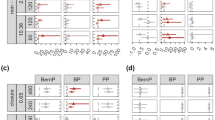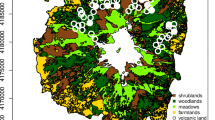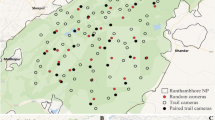Abstract
Measures of absolute animal abundance may be estimated by capture-recapture, removal, or distance sampling methods. We investigate the usage of binomial mixture models to estimate local group abundance of major prey species that is frequently used as a surrogate for prey abundance to study predator or prey-mediated ecological interactions such as predator-prey relationships. We evaluate mixture models using data from a camera-trapping survey intended for a tiger Panthera tigris census in Chitwan National Park, Nepal, where the entire park was surveyed in 361 4-km2 quadrats. We chose four prey species (chital Axis axis, sambar Rusa unicolor, muntjac Muntiacus muntjac, and wild boar Sus scrofa) that collectively account for > 75% of prey biomass consumed by tigers. Abundance of prey group was modeled as a random variable with a Poisson or a negative binomial distribution, with the mean abundance affected by distance from water sources, elevation, and normalized difference vegetation index (NDVI). Except for wild boar, the top models for all other species included the hypothesized covariates while the null model was the most parsimonious model for the wild boar. The most parsimonious chital model included effects of distance from water sources (−) and elevation (−). The sambar model supported all three covariates: distance from water sources (−), elevation (+), and NDVI (+). Only distance from water sources (−) was supported by the most parsimonious muntjac model. Our abundance estimates also conformed to the results obtained from recently conducted labor-intensive distance sampling procedure. We conclude that camera-trapping survey data can be effectively utilized adopting the binomial mixture model framework to understand animal abundance-habitat relationships and estimate abundance of animal that are not identifiable individually.






Similar content being viewed by others
References
Adams R, Thibault K (2006) Temporal resource partitioning by bats at water holes. J Zool 270:466–472
Bhuju UR, Shakya PR, Basnet TB, Shrestha S (2007) Nepal biodiversity resource book: protected areas, Ramsar sites, and World Heritage sites. International Centre for Integrated Mountain Development (ICIMOD), Kathmandu, Nepal
Biswas S, Sankar K (2002) Prey abundance and food habit of tigers (Panthera tigris tigris) in Pench National Park, Madhya Pradesh, India. J Zool 256:411–420
Bliss CI, Fisher RA (1953) Fitting the negative binomial distribution to biological data. Biometrics 9:176–200
Boyd C, Castillo R, Hunt GL, Punt AE, VanBlaricom GR, Weimerskirch H, Bertrand S (2015) Predictive modelling of habitat selection by marine predators with respect to the abundance and depth distribution of pelagic prey. J Anim Ecol 84:1575–1588
Buckland ST, Burnham KP, Augustin NH (1997) Model selection: an integral part of inference. Biometrics 53:603–618
Burnham K, Anderson D (2002) Model selection and multimodal inference: a practical information-theoretic approach, 2nd edn. Springer-Verlag, New York
Carter NH, Gurung B, Viña A, Campa H III, Karki JB, Liu J (2013) Assessing spatiotemporal changes in tiger habitat across different land management regimes. Ecosphere 4:1–19
Carter NH, Shrestha BK, Karki JB, Pradhan NMB, Liu J (2012) Coexistence between wildlife and humans at fine spatial scales. Proc Natl Acad Sci 109:15360–15365
Creel S, Schuette P, Christianson D (2014) Effects of predation risk on group size, vigilance, and foraging behavior in an African ungulate community. Behav Ecol 25:773–784
Damm P (2010) Using automated cameras to estimate wildlife populations
DeFries R, Townshend J (1994) NDVI-derived land cover classifications at a global scale. Int J Remote Sens 15:3567–3586
Dhakal M et al. (2014) Status of tigers and prey in Nepal. Department of National Parks and Wildlife Conservation, Kathmandu, Nepal
Dhungel SK, O'Gara BW (1991) Ecology of the hog deer in Royal Chitwan National Park, Nepal. Wildl Monogr:3–40
Diefenbach DR, Brauning DW, Mattice JA, Thompson F III (2003) Variability in grassland bird counts related to observer differences and species detection rates. Auk 120:1168–1179
Dinerstein E (1980) An ecological survey of the Royal Karnali-Bardia Wildlife Reserve, Nepal: part III: ungulate populations. Biol Conserv 18:5–37
Dixon PM (2002) Bootstrap resampling. In: Shaarawi AH, Piegorsch WW (eds) Encyclopedia of environmetrics. John Wiley & Sons, Ltd
Elgar MA (1989) Predator vigilance and group size in mammals and birds: a critical review of the empirical evidence. Biol Rev 64:13–33
Fiske I, Chandler R (2011) Unmarked: an R package for fitting hierarchical models of wildlife occurrence and abundance. J Stat Softw 43:1–23
Gamon JA, Field CB, Goulden ML, Griffin KL, Hartley AE, Joel G, Penuelas J, Valentini R (1995) Relationships between NDVI, canopy structure, and photosynthesis in three Californian vegetation types. Ecol Appl 5:28–41
Geist V (1998) Deer of the world: their evolution, behaviour, and ecology. Stackpole books, Pennsylvania
Gurung K (1983) Heart of the jungle: the wildlife of Chitwan, Nepal. Andrew Deutsch Limited, London, UK
Kafley H, Gompper ME, Sharma M, Lamichane BR, Maharjan R (2016) Tigers (Panthera tigris) respond to fine spatial-scale habitat factors: occupancy-based habitat association of tigers in Chitwan National Park, Nepal. Wildl Res 43:398–410
Kafley H, Khadka M, Sharma M 2009 Habitat evaluation and suitability modeling of Rhinoceros unicornis in Chitwan National Park, Nepal: a geospatial approach. In: XIV World Forestry Congress, Buenos Aires, Argentina, . XIV World Forestry Congress, p 53
Karanth KU (1995) Estimating tiger Panthera tigris populations from camera-trap data using capture-recapture models. Biol Conserv 71:333–338
Karanth KU (1999) Prey depletion as a critical determinant of tiger population viability. Riding the tiger: tiger conservation in human dominated landscapes, pp 100–113
Karanth KU, Gopalaswamy AM, Kumar NS, Vaidyanathan S, Nichols JD, MacKenzie DI (2011) Monitoring carnivore populations at the landscape scale: occupancy modelling of tigers from sign surveys. J Appl Ecol 48:1048–1056
Karanth KU, Nichols JD (1998) Estimation of tiger densities in India using photographic captures and recaptures. Ecology 79:2852–2862
Karanth KU, Sunquist ME (1995) Prey selection by tiger, leopard and dhole in tropical forests. J Anim Ecol 64:439–450
Karki JB, Pandav B, Jnawali SR, Shrestha R, Pradhan NMB, Lamichane BR, Khanal P, Subedi N, Jhala YV (2015) Estimating the abundance of Nepal’s largest population of tigers Panthera tigris. Oryx 49:150–156
Keever AC, McGowan CP, Ditchkoff SS, Acker PK, Grand JB, Newbolt CH (2017) Efficacy of N-mixture models for surveying and monitoring white-tailed deer populations. Mammal Research 62:413–422
Kéry M (2008) Estimating abundance from bird counts: binomial mixture models uncover complex covariate relationships. Auk 125:336–345
Kery M, Royle JA (2015) Applied hierarchical modeling in ecology: analysis of distribution, abundance and species richness in R and BUGS, vol 1. Prelude and Static Models. Academic Press, Londres, Reino Unido
Kéry M, Royle JA, Schmid H (2005) Modeling avian abundance from replicated counts using binomial mixture models. Ecol Appl 15:1450–1461
Kilburn J (2018) Spatial variability in abundance, detectability and survival of white-tailed deer across a heterogeneous landscape of fear. University of Connecticut
Kittle AM, Bukombe JK, Sinclair AR, Mduma SA, Fryxell JM (2016) Landscape-level movement patterns by lions in western Serengeti: comparing the influence of inter-specific competitors, habitat attributes and prey availability. Mov Ecol 4:17
Krause J, Ruxton GD (2002) Living in groups. Oxford University Press, New York
Laurie WA (1978) The ecology and behaviour of the greater one-horned rhinoceros. Selwyn College,
Lehmkuhl JF (1990) The ecology of a south Asian tall grass community. Dissertation Abstracts International B, Sciences and Engineering 50
Lehmkuhl JF (1994) A classification of subtropical riverine grassland and forest in Chitwan National Park, Nepal. Vegetatio 111:29–43
Lillesand TM, Kiefer RW, Chipman JW (2004) Remote sensing and image interpretation, vol Ed. 5. John Wiley & Sons Inc., Hoboken
Link WA, Sauer JR (1998) Estimating population change from count data: application to the North American breeding bird survey. Ecol Appl 8:258–268
Lunetta RS, Knight JF, Ediriwickrema J, Lyon JG, Worthy LD (2006) Land-cover change detection using multi-temporal MODIS NDVI data. Remote Sens Environ 105:142–154
MacKenzie DI (2006) Occupancy estimation and modeling: inferring patterns and dynamics of species occurrence. Academic Press, Burlington
Manly BF (2006) Randomization, bootstrap and Monte Carlo methods in biology, vol 70. CRC Press
Masek JG, Vermote EF, Saleous NE, Wolfe R, Hall FG, Huemmrich KF, Gao F, Kutler J, Lim TK (2006) A Landsat surface reflectance dataset for North America, 1990-2000. Geosci Remote Sens Lett, IEEE 3:68–72
Mishra HR (1982) The ecology and behaviour of chital (Axis axis) in the Royal Chitwan National Park, Nepal: with comparative studies of hog deer (Axis porcinus), sambar (Cervus unicolor) and barking deer (Muntiacus muntjak). University of Edinburgh
Moeller AK, Lukacs PM, Horne JS (2018) Three novel methods to estimate abundance of unmarked animals using remote cameras. Ecosphere 9:e02331
O'Brien TG, Kinnaird MF, Wibisono HT (2003) Crouching tigers, hidden prey: Sumatran tiger and prey populations in a tropical forest landscape. Anim Conserv 6:131–139
Reed BC, Brown JF, VanderZee D, Loveland TR, Merchant JW, Ohlen DO (1994) Measuring phenological variability from satellite imagery. J Veg Sci 5:703–714
Reyna-Hurtado R, Beck H, Altrichter M, Chapman CA, Bonnell TR, Keuroghlian A, Desbiez AL, Moreira-Ramírez JF, O'Farrill G, Fragoso J, Naranjo EJ (2016) What ecological and anthropogenic factors affect group size in white-lipped peccaries (Tayassu pecari)? Biotropica 48:246–254
Rovero F, Marshall AR (2009) Camera trapping photographic rate as an index of density in forest ungulates. J Appl Ecol 46:1011–1017
Rowcliffe JM, Field J, Turvey ST, Carbone C (2008) Estimating animal density using camera traps without the need for individual recognition. J Appl Ecol 45:1228–1236
Royle JA (2004) N-mixture models for estimating population size from spatially replicated counts. Biometrics 60:108–115
Royle JA, Dorazio RM (2006) Hierarchical models of animal abundance and occurrence. J Agric Biol Environ Stat 11:249–263
Royle JA, Nichols JD (2003) Estimating abundance from repeated presence-absence data or point counts. Ecology 84:777–790
Schaller GB (1967) The deer and the tiger. University of Chicago Press, Chicago and London
Seidensticker J (1976) Ungulate populations in Chitawan valley, Nepal. Biol Conserv 10:183–210
Selmi S, Boulinier T (2003) Does time of season influence bird species number determined from point-count data? A capture-recapture approach. J Field Ornithol 74:349–356
Silver SC, Ostro LET, Marsh LK, Maffei L, Noss AJ, Kelly MJ, Wallace RB, Gómez H, Ayala G (2004) The use of camera traps for estimating jaguar Panthera onca abundance and density using capture/recapture analysis. Oryx 38:148–154
Smit IP, Grant CC, Devereux BJ (2007) Do artificial waterholes influence the way herbivores use the landscape? Herbivore distribution patterns around rivers and artificial surface water sources in a large African savanna park. Biol Conserv 136:85–99
Smith JLD, McDougal C, Ahearn SC, Joshi A, Conforti K (1999) Metapopulation structure of tigers in Nepal. In: Seidensticker J, Christie S, Jackson P (eds) Riding the tiger: tiger conservation in human-dominated landscapes. Cambridge University Press, Cambridge, pp 176–189
Sunquist M, Karanth KU, Sunquist F (1999) Ecology, behaviour and resilience of the tiger and its conservation needs. In: Seidensticker J, Christie S, Jackson P (eds) Riding the tiger: tiger conservation in human-dominated landscapes. Cambridge University Press, Cambridge, pp 5–18
Thapa K (2014) Ecology of tigers in churia habitat and a non-invasive genetic approach to tiger conservation in Terai arc. Virginia Polytechnic Institute and State University, Nepal
Thapa TB (2012) Habitat suitability evaluation for leopard (Panthera pardus) using remote sensing and GIS in and around Chitwan National Park, Nepal. Wildlife Institue of India
Thurfjell H, Ball JP, Åhlén P-A, Kornacher P, Dettki H, Sjöberg K (2009) Habitat use and spatial patterns of wild boar Sus scrofa (L.): agricultural fields and edges. Eur J Wildl Res 55:517–523
White GC, Bennetts RE (1996) Analysis of frequency count data using the negative binomial distribution. Ecology 77:2549–2557
Whitehead GK (1972) Deer of the world. Constable & Company Ltd., London
Zhu Z, Wang S, Woodcock CE (2015) Improvement and expansion of the Fmask algorithm: cloud, cloud shadow, and snow detection for Landsats 4-7, 8, and Sentinel 2 images. Remote Sens Environ 159:269–277
Zhu Z, Woodcock CE (2012) Object-based cloud and cloud shadow detection in Landsat imagery. Remote Sens Environ 118:83–94
Acknowledgements
We thank the Department of National Parks and Wildlife Conservation of the Government of Nepal for permitting our involvement in the field surveys and research. The World Wildlife Fund (WWF) Nepal Program and the National Trust for Nature Conservation provided necessary field support. Megh Bahadur Pandey, Dr. Maheshwor Dhakal, and Dr. Shant Raj Jnawali were very helpful in enabling HK to garner permission for field work.We thank three anonymous reviewers for their constructive comments to help us improve the manuscript.
Funding
HK was supported by WWF’s Kathryn Fuller doctoral fellowship, a National Geographic Society Waitt grant, and by the graduate school of the University of Missouri during this research.
Author information
Authors and Affiliations
Corresponding author
Additional information
Publisher’s note
Springer Nature remains neutral with regard to jurisdictional claims in published maps and institutional affiliations.
Rights and permissions
About this article
Cite this article
Kafley, H., Lamichhane, B.R., Maharjan, R. et al. Estimating prey abundance and distribution from camera trap data using binomial mixture models. Eur J Wildl Res 65, 77 (2019). https://doi.org/10.1007/s10344-019-1308-0
Received:
Revised:
Accepted:
Published:
DOI: https://doi.org/10.1007/s10344-019-1308-0




